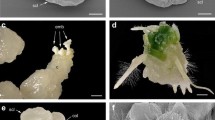Summary
In the synthesis of primary hexaploid triticale, a cross-incompatibility barrier exists when tetraploid wheat (4X) is crossed with diploid (2X) rye. Fertilization may occur, however, abnormal endosperm development usually leads to premature embryo death. Four selected tetraploid wheat lines were crossed as females with seven open-pollinated rye lines and the resulting embryos were rescued in vitro 13–16 days after pollination. The wheat genotypes showed a major influence on crossability (seed set), embryo development and plant recovery. The highest efficiency of amphihaploid plant recovery (18.3 plants per 100 pollinated florets) was obtained from one 4X wheat line originally selected from the cross T. carthlicum × T. dicoccoides. Some of the 3X amphihaploid plants (ABR) derived from two wheat lines showed relatively high level of partial fertility presumably as a result of meiotic restitution. Correlation analysis showed that crossability (seed set), normal hybrid embryo development in vivo and embryo culturability were independent of each other.
Similar content being viewed by others
References
Chauhan, K.P.S. & M.Z. Patel, 1978. Crossability of wheat-rye haploids with hexaploid triticale. In: Proceedings of the Fifth International Wheat Genetics Symposium, New Delhi, India. 23–28 February 1978. pp. 1154–1160.
Darvey, N.L. & S. Durvasula, 1980. Chromosome pairing and restitution in wheat-rye amphihaploids. In: Proceedings of the Second International Conference on Rye and Triticale, Poznan, Poland, 11–14 May 1980. pp. 67–68 (Abstract).
Darvey, N.L. 1991. Germplasm creation centers and banks for spring, winter and facultative triticale. In: Proceedings of the Second International Triticale Symposium, Passo Fundo, Rio Grande do Sul, Brazil, 1–5 October, 1990. pp. 14–19.
Falk, D.E. & K.J. Kasha, 1983. Genetic studies of the crossability of hexaploid wheat with rye and Hordeum bulbosum. Theoretical and Applied Genetics 64: 303–307.
GENSTAT 5 Reference Manual, 1987. Oxford University Press: U.K.
Immonen, A.S.T., Pfeiffer, W.H. & R.M. Trethowan, 1991. 4X and 6X wheat and rye progenitors in primary triticale production. In: Proceedings of the 2nd International Triticale Symposium, Passo Fundo, Rio Grande do Sul, 1–5 October 1990, pp. 383–386.
Jalani, B.S. & P.J. Moss, 1980. The site of action of the crossability genes (Kr 1 and Kr 2) between Triticum and Secale. I. Pollen germination, pollen tube growth and number of pollen tubes in common wheat. Euphytica 29: 571–579.
Jalani, B.S. & P.J. Moss, 1981. The effects of species, polyploidy and embryo transplantation on the crossability between Triticum and Secale. Z. Pflanzenzüchtung 86: 286–297.
Kaltsikes, P.J., 1974. Methods for triticale production. Z. Pflanzenzüchtung 71: 264–286.
Lange, W. & B. Wojciechowska, 1976. The crossing of common wheat (Triticum aestivum L.) with cultivated rye (Secale cereale L.) I. Crossability, pollen grain germination and pollen tube growth, Euphytica 25: 609–620.
Lein, A., 1943. Die genetische Grundlage der Kreuzbarkeit zwischen Weizen und Roggen. Z. ind. Abst.-, Vererbungslehre 81: 28–61.
Lelley, T. & T. Taira, 1979. Effect of genotype on response to colchicine treatment in wheat × rye hybrids. Z. Pflanzenzüchtung 82: 87–89.
Maan, S.S. & T. Sasakuma, 1977. Fertility of amphihaploids in Triticinae. Journal of Heredity 68: 87–94.
Murashige, T. & F. Skoog, 1962. A revised medium for rapid growth and bioassays with tobacco tissue cultures. Physiologia Plantarum 15: 473–497.
Oettler, G., 1982. Effect of parental genotype on crossability and response to colchicine treatment in wheat-rye hybrids. Z. Pflanzenzüchtung 88: 322–330.
Oettler, G., 1983. Crossability and embryo development in wheat-rye hybrids. Euphytica 32: 593–600.
Oettler, G., 1984. Parental effects on crossability, embryo differentiation and plantlet recovery in wheat × rye hybrids. Euphytica 33: 233–239.
Riley, R. & V. Chapman, 1967. The inheritance in wheat of crossability with rye. Genetics Research 9: 259–267.
Taira, T. & E.N. Larter, 1978. Factors influencing development of wheat-rye hybrid embryos in vitro. Crop Science 18: 348–350.
Taira, T., T. Lelley & E.N. Larter, 1978. Influence of parental rye on the development of embryos and endosperm of wheat-rye hybrids. Canadian Journal of Botany 56: 386–390.
Taira, T., Z.Z. Zhao, H. Hamawaki & E.N. Larter, 1991. The effect of colchicine as a chromosome doubling agent for wheat-rye hybrids as influenced by pH, method of application, and post-treatment environment. Plant Breeding 106: 329–333.
Verzea, M., 1991. Crossability of tetraploid and hexaploid wheats with diploid rye. In: Proceedings of the Second International Triticale Symposium, Passo Fundo, Rio Grande do Sul, Brazil, 1–5 October 1990. pp. 157–160.
Wojciechowska, B. & W. Lange, 1977. The crossing of common wheat (Triticum aestivum L.) with cultivated rye (Secale cereale L.). II. Fertilization and early-post fertilization developments. Euphytica 26: 287–297.
Xu, S. & Y. Dong. Cytogenetic studies on the spontaneous formation of amphiploids in the F1 hybrids of Triticum carthlicum Nevski var. darginicum with Aegilops tauschii Cosson (personal communication).
Author information
Authors and Affiliations
Rights and permissions
About this article
Cite this article
Balatero, C.H., Darvey, N.L. Influence of selected wheat and rye genotypes on the direct synthesis of hexaploid triticale. Euphytica 66, 179–185 (1992). https://doi.org/10.1007/BF00025301
Received:
Accepted:
Issue Date:
DOI: https://doi.org/10.1007/BF00025301




